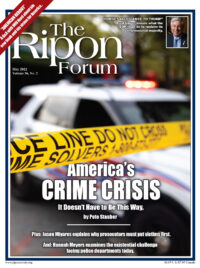
Presumed innocent and unconvicted, almost 75% of the U.S. jail population sit in jail awaiting a hearing or trial. They sit in overcrowded concrete cages lacking in air-conditioning, and stained with feces. Like in a dystopian science fiction novel, the sole legal justification for their incarceration involves speculation about what they might do if released.
Our Founding Fathers were so concerned about governmental threats to liberty that they placed numerous barriers to protect it. The right to due process. The guarantee of a jury trial. Prohibitions against excessive bail.
It should be hard for the government to take away someone’s freedom; especially so when a person has not been convicted of any crime. The government should have to provide persuasive evidence that a defendant poses an immediate risk of serious crime or flight. Moreover, the government should need to demonstrate not only that such risk exists, but that there are no less restrictive alternatives than jail that could prevent the threatened harm.
It should be hard for the government to take away someone’s freedom; especially so when a person has not been convicted of any crime.
Current practice eviscerates these standards. Our pretrial system is a Kafkaesque regime in which the government has almost unmitigated power to detain.
Bail is determined in assembly-line fashion. Each bail hearing lasts only a minute or two.
Defendants have no opportunity to speak in their defense. They have no access to counsel.
The prosecutor is not required to present any evidence.
The presiding magistrate – often not even a judge or lawyer – takes a quick glance at the charges and sets bail. This number then determines that person’s freedom.
If they can come up with the nonrefundable 10% deposit required by the bail bondsman, they go home.
If not, they sit in jail.
And when the prosecutor comes to offer them a “plea deal” they take it. I put “deal” in quotes because a deal suggests a negotiation between equal parties. A defendant in his cell has no bargaining chips. He takes what’s offered, particularly if it gets him out of that cage.
You may be tempted to believe that the administration of criminal law is some sort of governmental unicorn – thorough, effective, and unlikely to err. That these people are getting what they deserve, even if the procedure is a little slapdash. Well, anytime you have a bureaucratic assembly-line process, errors will be rampant.
As an example, consider the hundreds of people in Harris County, Texas who pled guilty to drug charges based on error-prone drug tests administered in the field. These people were arrested, detained, and offered a plea deal that allowed them to go home.
They took it.
Later, lab tests showed that they were innocent. But the exonerating results – sent by email to the district attorney – were either never read or never followed up on. The false convictions were allowed to stand for years. And it was only a rare confluence of events – a careful journalist, a conscientious prosecutor, and the uncommon practice of testing drugs after guilty plea – that ever allowed these errors to come to light.
Our pretrial system needs more than a facelift. It needs to be torn down and rebuilt so that no one can be stripped of their liberty without clear and convincing evidence.
You may be tempted to believe that most people sitting in jail would be committing serious violent crime if released. Not so. A quarter of our nation’s jail populations are facing only misdemeanor charges. Even those facing felonies were mostly deemed low enough risk by the judge that bail was set at only moderate levels. They would be released immediately if they could afford it.
Given the enormous human and taxpayer cost of incarceration, the benefits of prevented crime are simply not worth it in most cases. Punishment should happen after conviction, not before it.
Our pretrial system needs more than a facelift. It needs to be torn down and rebuilt so that no one can be stripped of their liberty without clear and convincing evidence that they pose a high risk of serious crime or flight: a risk that cannot be mitigated with less restrictive options than jail. This evidence must be presented in a thorough hearing with defense counsel present. Not a one-minute farce like currently exists.
The government’s power to take a man from his home and place him in a cage is one we should be fearful of. It is a power we should grant with suspicion, monitor constantly, and guard carefully against abuse.
Megan T. Stevenson is an Associate Professor of Law and Economics at the University of Virginia’s School of Law.




